Venus flytraps (Dionea muscipula) and other carnivorous plants do not follow traditional plant “rules.” Once you move away from conventional plant care, you’ll be able to keep these peculiar plants alive with minimal issues. Here you’ll learn how often you need to water your Venus flytrap and some other critical care tips to keep it happy and healthy.
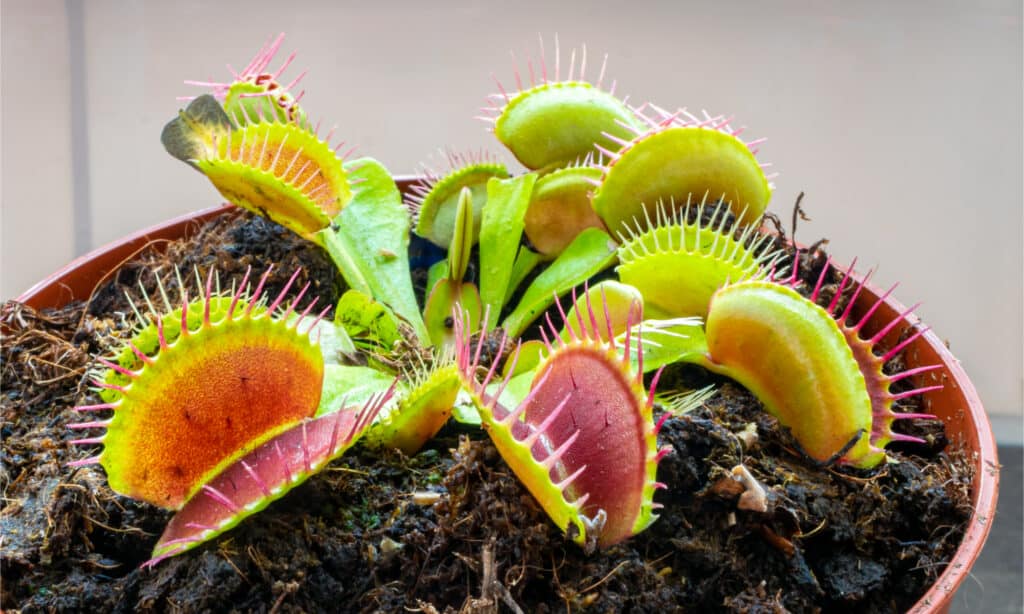
Venus flytraps are endemic to regions in North and South Carolina.
©Menno van der Haven/Shutterstock.com
How Often Do You Water a Venus Fly Trap?
You never want the soil to dry out for your Venus flytrap. These plants, unlike many others, don’t mind standing water and always need moist substrate to survive. Making sure your Venus flytrap has enough water (of the right kind) is probably the number one tip to keep your plant from dying. Additionally, it makes things easier for those who are heavy-handed with watering.
You can keep a Venus flytrap in a small pot sitting in another container of water. If this is the method you use, try to keep the container the pot is sitting in halfway full at all times. Venus flytraps are adapted to live in marsh and swamp-like conditions. So, these plants are okay living in shallow puddles and consistently damp environments.
1. Use the Right Type of Water
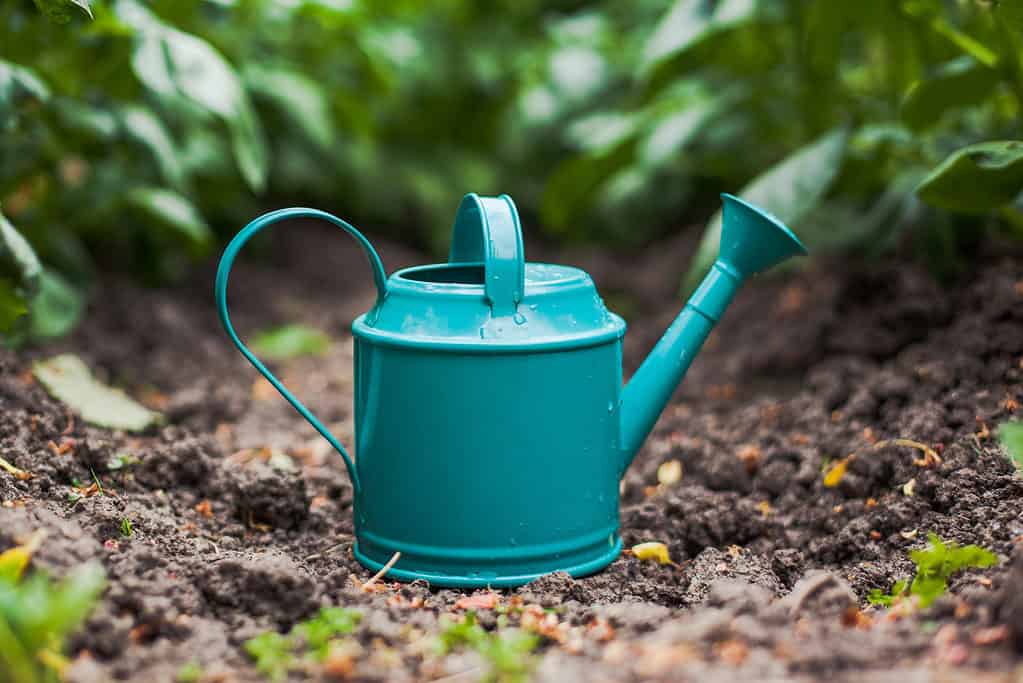
You can set a bucket or watering can out on a rainy day to catch some water for your plants.
©iStock.com/Tgordievskaya
Now that we’ve covered how much water a Venus flytrap prefers, we have to cover what kind of water is needed. Carnivorous plants in general are very sensitive to minerals and chemicals in soil and water. For this reason, tap water is a no-go. It is almost guaranteed to kill your Venus flytrap or other carnivorous plants in your care. Even water run through a purifier is likely still too high in dissolved salts or minerals. So, skip the Brita filter altogether. Ideally, rainwater or reverse osmosis water should be used on your plant. Distilled water is also a good choice.
If you use tap water accidentally to water your plant once, you can do some damage control. Run the soil through with distilled water immediately. Doing this will help flush out some of the minerals and salts present in the tap water.
2. Provide Acidic, Nutrient-Poor Soils

Marshes are usually wet, while swamps are often flooded with deep water and stay wet for the entire year.
©Earl D. Walker/Shutterstock.com
Venus flytraps and other carnivorous plants evolved to eat insects due to the nutrient-poor conditions they grow in. For this reason, it’s best to keep their soil acidic and unfertilized. Since they’ve adapted other ways to get nutrients (from eating bugs) they have almost no need for soil nutrients like nitrogen. So, while you might think adding some all-purpose fertilizer will help care for your Venus flytrap, it’s going to do more harm than good!
Aim to keep your flytraps in a substrate that consists mostly of peat moss and sand in equal parts. This will remain water-retaining but also provide some drainage to avoid issues like rot. If you’re in doubt about the soil, just think of what you might see in a marsh. By mimicking its natural habitat as closely as possible you can guarantee a thriving plant.
You won’t need to immediately repot a flytrap after purchasing it. After two years or so, you can choose a pot one size larger and refresh the substrate with a sterilized mix of 50% sand and 50% peat moss.
3. Maintain Above Average Humidity
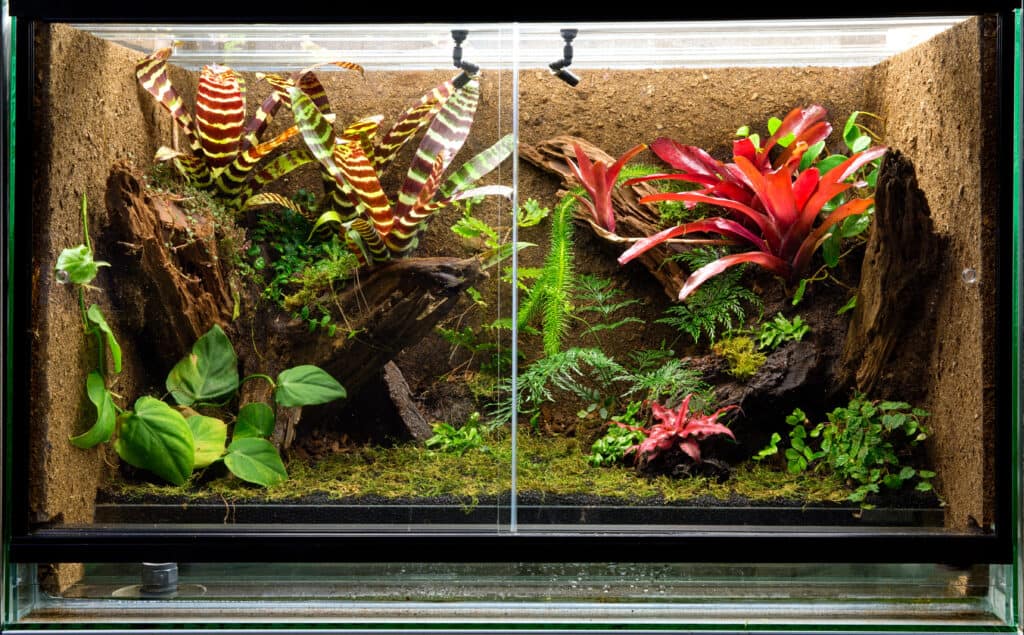
A terrarium can hold many different plants that have the same care needs in an easy-to-care-for setup.
©Dirk Ercken/Shutterstock.com
While flytraps aren’t the most dramatic when it comes to humidity, they do need levels above 50%. Fortunately, you can provide this in the same way you make sure it has enough water. By placing its pot in another container filled halfway with water, evaporation can provide a good amount of supplemental humidity.
Additionally, if you keep this plant in a terrarium, the enclosed space will provide more than enough humidity to reach its preferred levels. However, be sure the terrarium is not entirely closed off. Having a glass top propped open or even a mesh top can provide the airflow needed to avoid rot while also maintaining the right levels of humidity.
If you’re not terrarium-growing and you live in a dry area, you can always get a humidity gauge to check percentages. If humidity levels are under 50%, mist it regularly with the same water you’d use to water the plant. A humidifier is likely overkill for these carnivores, but you’re more than welcome to invest in one and keep it around 60% humidity.
4. Keep Them Warm
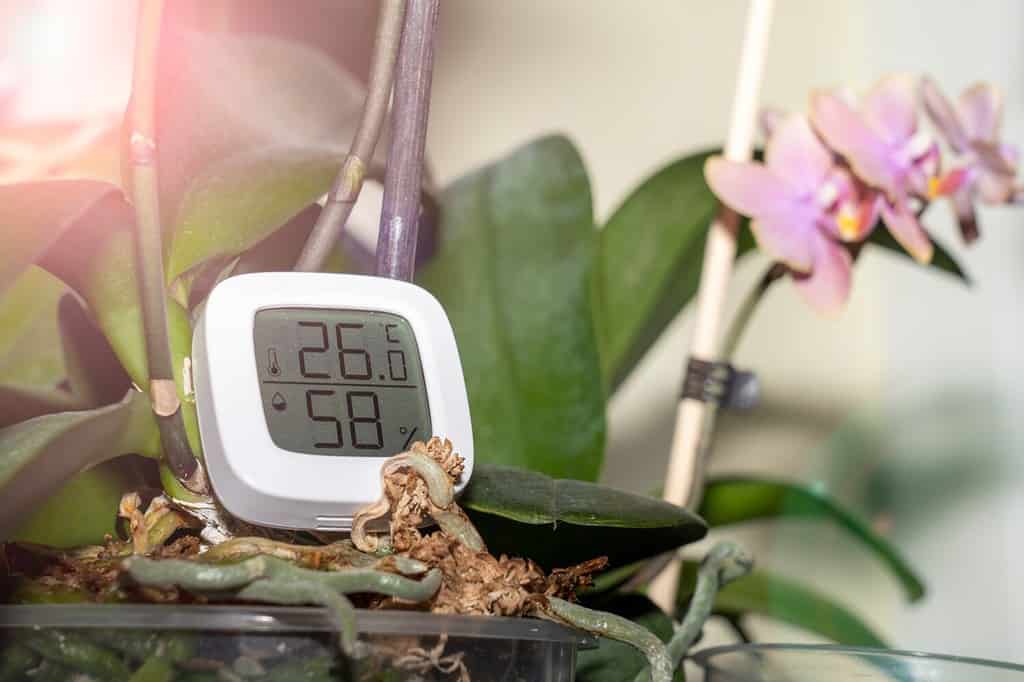
A tip for your Venus flytraps: take the guesswork out of determining the humidity with a hygrometer.
©AntonSAN/Shutterstock.com
The ideal temperature for most of the year for your flytraps will be between 70-90°F. However, 95°F is okay; just know it is getting closer to the danger zone where your plants might start to overheat. If you’re growing them outdoors in a pond, be sure they have some access to shade during the summer, so the plants won’t wilt and start to die off. Maintaining the right temperature is quite easy indoors, especially since they are acclimated to the same ambient temperatures as the people inhabiting the house.
Terrariums are even easier for most of the year since they tend to be very stable in temperature. However, terrarium growing might raise some issues when it comes to the requisite dormancy period in winter; there will be more on that soon!
5. Give Them Bright Light
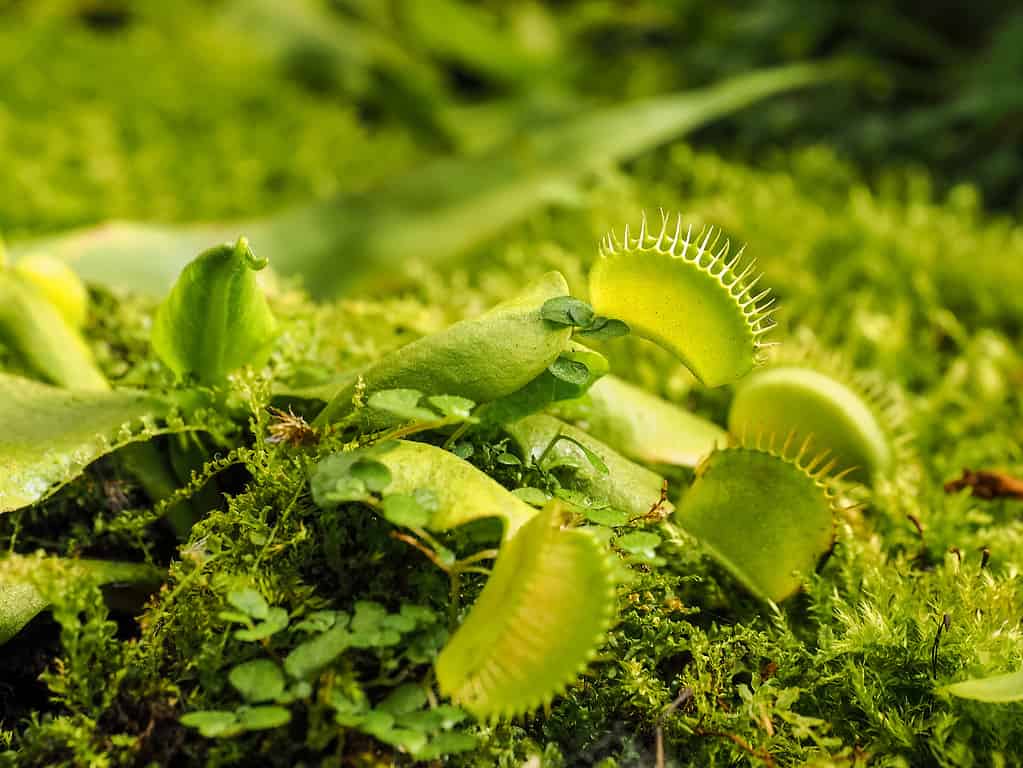
Bright light and warm temperatures from the sun can kill off mold that might be growing in the soil.
©Evgeniy Bobkov/ via Getty Images
As with warm temperatures, Venus flytraps love to get a good amount of bright light. Preferably, this means at least six hours of direct light. In nature, flytraps are dependent on a forest fire or burn to kill off plants and parts of trees that shade them out. Direct sunlight is imperative to their overall function and ability to flourish.
If you’re growing the plant outside or in a pot in the house, aim for southern-facing light exposure. This is the brightest and longest type of light in the day. In a terrarium, you can use a standard grow light programmed for six to 12 hours, depending on the intensity of the light and how far away the flytraps are from the light source.
6. Care is a Little Different During the Winter
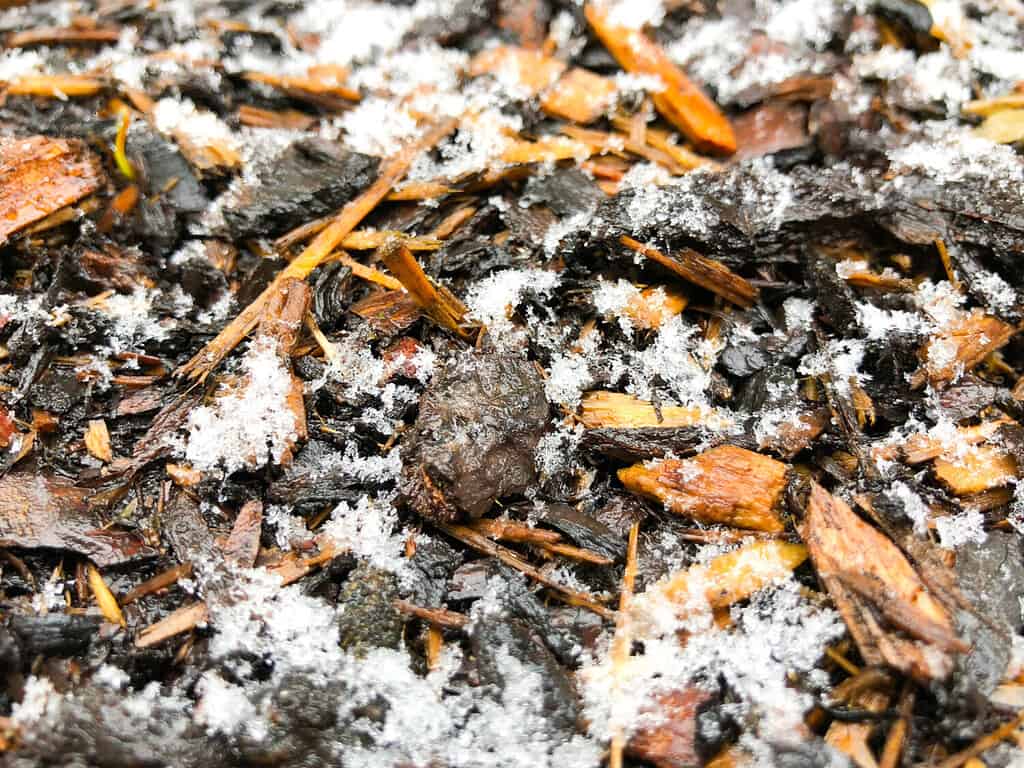
While flytraps are tolerant to cooler temperatures, frost damage can easily kill in one cold night.
©Ilaha Aliyeva/Shutterstock.com
Venus flytraps require a period of dormancy. Without this, they will not be as robust when they grow back the next season. During this time, some traps might die off and the leaves will turn dark around the edges. For those who don’t know of this plant’s rest period, it can be quite alarming! Rest assured, it’s normal and very healthy for these plants to have three or four months of rest. Usually, it will start in October and end in February.
Outdoor Dormancy
If you’re growing the plant outdoors, especially in USDA Zone 8, you won’t need to do much. Ensure you are still watering them and, if temperatures drop below 20°F or there are very high winds, you can cover them with a tarp or move them indoors to a garage or basement. The ideal temperature for dormancy is below 50°F but above freezing. Shorter daylight hours follow this drop in temperature.
Indoor Dormancy
For plants that are grown in terrariums, achieving this dormant period is a little more involved, but not impossible. Firstly, make sure you’re considering dormancy when starting a terrarium that includes Venus flytraps. It should consist of Venus flytraps exclusively or other plants that prefer a chilly period, like sundews or sarracenias. You can set your terrarium’s light to a less intense setting on a shorter timer and remove the lid for the season. Placing the whole terrarium in front of or near a window (or in a garage or basement) can help it get to the temperatures it needs.
If you kept the flytraps in a small pot inside a terrarium, then preparing them for winter is much easier. You just have to take their pot, along with their accompanying saucer of water, to an area that will get chilly. If you’ve been growing your plants in a window, then simply moving them from a south-facing window to an east-facing window may achieve the requirements of lower temperature and less sun exposure.
Summary of 6 Critical Care Tips for a Thriving Venus Flytrap
| 1. Use the right type of water |
| 2. Provide acidic, nutrient-poor soils |
| 3. Maintain above-average humidity |
| 4. Keep them warm |
| 5. Give them bright light |
| 6. Care is a little different during the winter |
The photo featured at the top of this post is © Kuttelvaserova Stuchelova/Shutterstock.com
Thank you for reading! Have some feedback for us? Contact the AZ Animals editorial team.







